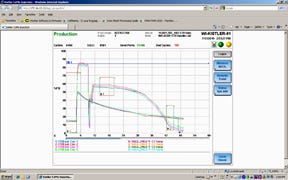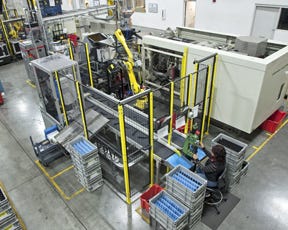Monitoring system is key for
automotive entry-system supplier
Data drives the world today, and an auto molder found a production- and process-monitoring system that made the data pay for itself.
November 10, 2010
Data drives the world today, and an auto molder found a production- and process-monitoring system that made the data pay for itself.
"Automotive customers can be demanding,” says Keith Bagley, process engineer for Huf North America, (Milwaukee, WI). “They insist on quality and it’s our job to deliver. To do that, we’ve got to eliminate the process variability that causes defects. Then we need to recognize immediately when there’s a problem and prevent potentially faulty parts from getting through to the customer. If the customer ever does identify an issue, we need to be able to determine whether it is the fault of the molding process and, if it is, we’ve got to be able to pinpoint the cause and fix it. And, we’ve got to do all this while staying productive and profitable.”
|
It’s a tall order, and the recent slump in the automotive industry has only made things more challenging, but Bagley says that Huf NA is starting to get its arms around the challenge. The company makes extensive use of robotics (mostly six-axis articulated-arm robots from Fanuc) and process control equipment (Kistler CoMo cavity-pressure and temperature monitors). But the thing that brings the whole plant together, addressing both quality and productivity issues, is information—reams of it—delivered in real time by a Syscon-PlantStar production- and process-monitoring system.
“Until we got the PlantStar system in 2007,” recalls Huf NA’s IT director, Tom Jones, “all we could do was print out the raw process data from the injection molding machine controls. If we wanted to identify the cause of a problem, we had to manually sift through pages and pages of information. It was very time-consuming and really not very helpful. Today, the PlantStar system draws that information together continuously, and makes it available immediately to anyone who might need it.” In fact, Jones says, some customers require that Huf have a production- and process-monitoring system like PlantStar in order to validate its processes.
Huf North America is part of Huf Hülsbeck & Fürst GmbH & Co. KG in Velbert, Germany, which develops and produces a broad range of mechanical and electronic key systems, lock sets, steering locks, and remote control systems for the automotive industry.
Seeking Six Sigma quality
Ask Bagley to show you the PlantStar system in action, and he’ll show you a fully automated injection molding cell making door handles from 30%-glass-filled nylon. A Toshiba servo-electric injection molding machine equipped with gas assist runs a four-cavity tool to produce two right-hand parts and two left-hand parts on a 60-second cycle.
Bagley has determined that gas pressure at certain points in the cycle is critical. That’s where the Kistler unit comes in. It monitors cavity pressures and temperatures. Of particular concern is are two sections—one near the top of the gas pressure curve and another near the bottom (visible in the screen shot above). If they are not within those prescribed windows, the part will need to be scrapped. The Kistler sensors also monitor mold temperature throughout the cycle, verifying that temperatures are within an acceptable range to ensure production of a quality part.
If the system determines that conditions are not right for producing a good part, a reject signal is sent to the part-removal robot, which then scraps only the part produced in the cavity where the variation was detected. The robot control then reports production numbers (good parts/bad parts) to the PlantStar database.
Molding-machine-related parameters—actual readings of speeds, pressures, temperatures, and so on—are sent directly to the PlantStar database by the Toshiba control. Process variables outside of specified limits trigger an alarm, notifying a technician of the variation. When correlated with the machine alarms, the robot can be triggered by the injection molding machine to discard the shot.
PlantStar tracks all data and stores it, and keeps track of good parts produced and also reasons for reject parts. All the information is stored in the system and is available for viewing on the PlantStar operator interface monitor at the machine or other networked computers via a Web browser. The system also prints bar-coded labels for bins that each hold 40 handles, and all the data for those parts are associated in the database with all the parts in that bin.
“If a part fails in the field,” says quality director Bob Perry, “even 36 or 48 months after it was made, and the customer wants to see the processing history, PlantStar makes that possible.”
While the PlantStar data are not yet fully utilized in quality control, Bagley feels they have made a good start. “What I look for is process repeatability. We set up a job and fine-tune our tooling to produce a part that is acceptable to our customer. We then create the setup standards that are aimed at eliminating variations that might prevent us from producing a good part. If we follow that prescribed process, and we can document through the PlantStar data that the process is consistent, then we expect to have a good part.”
In the future, Huf NA hopes to do much more. “We really want to get a better understanding of the critical impact parameters for a given part,” says Bob Perry. “You don’t always know what the critical parameters are and how they affect part quality without a lot of really intense Six Sigma analysis. With the PlantStar system, we will more easily be able to organize that snow storm of data and then really hone in on those few critical flakes and make the necessary improvements.”
Reducing downtime
Until recently, Bagley says, the company had a problem with unassigned machine downtime. Employees simply did not understand the importance of logging a reason for downtime, and as recently as December 2009 the second most common reason for downtime in Huf NA’s plastics plant was “Unassigned.”
To educate shop-floor personnel, Bagley began posting reports on downtime reasons generated through the PlantStar system. They list the top 10 reasons for machine downtime and assign a dollar value to the lost productivity (based on machine burden rates).
As they became more aware of the problem (and the costs associated with downtime), employees became more diligent about properly assigning downtime reasons. As a result of this improved awareness, by June 2010, unassigned downtime dropped from the second most common reason to seventh—from costing $17,818 in December 2009 to just less than $3500 in June 2010.
At the same time, these reports showed a dramatic increase in automation-related downtime, as “unassigned” downtime was properly allocated. The cost of automation problems jumped 22% from $17,988 in December 2009 to more than $22,000 in June 2010.
“For years,” says Bagley, “I was certain that automation-related issues were our biggest problem but I didn’t have the data to document it. PlantStar now validates my observations and I can have a more constructive conversation with management about making improvements. It’s not just my opinion anymore. I’ve got data to back it up.”
Reporting to Huf NA general manager Herwig Rau, Bagley also generates detailed reports on Overall Equipment Efficiency (OEE), which is among the PlantStar benefits that Rau appreciates most. OEE analysis—which synthesizes measures of quality (net pieces/gross pieces), machine availability (run time/run time + downtime), and productivity (cycles/run time/standard cycle)—returns a single efficiency number that can be compared to standards set to ensure profitability.
“I can see raw material shortages, equipment failures, downtime and maintenance issues, and a lot more,” Rau says. “I can get daily, weekly, or monthly reports that show me the root causes of inefficiency, even for individual machines on specific shifts.” Keep OEE at or above planned levels and you can be reasonably assured of a profitable operation, Rau says.
“We’re in a very tight market environment,” Rau concludes. ”We need to continually improve our quality and efficiency in order to overcome rising costs and compete successfully, and the PlantStar system is helping us do that.” —[email protected]
Fanuc Robotics | www.fanucrobotics.com
Huf North America | www.huf-group.com
Kistler Instrument | www.kistler.com
Syscon-PlantStar | www.plantstar.org
Toshiba Machine Co. America | 
www.toshiba-machine.com
Download a pdf of the full case study provided by Syscon-PlantStar.
About the Author(s)
You May Also Like




